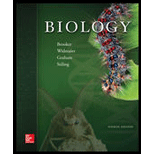
Concept explainers
Which of the following pathways occurs in the cytosol?
- a. glycolysis
- b. breakdown of pyruvate to an acetyl group
- c. citric acid cycle
- d. oxidative phosphorylation
- e. all of the above
Introduction: Conversion of glucose molecules to pyruvate molecules and the production of energy in the form of ATP and NADH occur through glycolysis. It is used for the cellular respiration of the cell through redox reactions. It may follow either the anaerobic pathway or the aerobic pathway to do so.
Answer to Problem 1TY
Correct answer: Glycolysis occurs in the cytosol. Hence, the correct answer is option a.
Explanation of Solution
Reason for correct answer:
Glycolysis occurs through two main stages. In the first phase, two molecules of glyceraldehyde-3-phosphate are produced from glucose. In the second phase, the molecules of glyceraldehyde-3-phosphate are converted to pyruvate. Both of these stages occur in the cytoplasm of the cell.
Option a. is given as “glycolysis”
The process of glycolysis occurs in the cytosol of cells. Hence, the correct answer is option a.
Reasons for incorrect answer:
Option b. is given as, “breakdown of pyruvate to an acetyl group”.
The outcome of glycolysis is pyruvate. It enters the mitochondria of the cell and is broken down to give acetyl molecules. The breakdown of pyruvate to an acetyl group occurs in the mitochondria. Hence, option b. is incorrect.
Option c. is given as, “citric acid cycle”.
The breakdown of pyruvate to an acetyl group occurs in the mitochondria. Further, acetyl coenzyme A reacts with oxaloacetate and enters the citric acid cycle. Citrate is produced by the reaction of acetyl coenzyme A and oxaloacetate. The citric acid cycle occurs in the mitochondria. Hence, option c. is incorrect.
Option d. is given as, “oxidative phosphorylation”.
Oxidative phosphorylation is the process by which electrons are transferred from NADH or FADH2 to oxygen molecules. This happens through a series of steps in which it passes though many electron carriers and results in the formation of ATP molecules. This occurs by the help of the enzyme ATP synthase present on the mitochondrial membrane. Hence, option d. is incorrect.
Option e. is given as, “all of the above”.
Breakdown of pyruvate to acetyl group and the citric acid cycle occur in the mitochondria and oxidative phosphorylation occurs in the mitochondrial membrane. Only glycolysis, represented by option a. occurs in the cytosol. Hence, option e. is incorrect.
Hence, the options b., c., d., and e. are incorrect.
Thus, glycolysis occurs in the cytosol in two phases. Breakdown of pyruvate to acetyl group and the citric acid cycle occur in the mitochondria and oxidative phosphorylation occurs in the mitochondrial membrane.
Want to see more full solutions like this?
Chapter 7 Solutions
Biology
Additional Science Textbook Solutions
Biological Science (6th Edition)
Genetics: From Genes to Genomes
Campbell Essential Biology (7th Edition)
HUMAN ANATOMY
Biology: Life on Earth with Physiology (11th Edition)
- Which of the following is not a DNA binding protein? 1. the lac repressor protein 2. the catabolite activated protein 3. the trp repressor protein 4. the flowering locus C protein 5. the flowering locus D protein 6. GAL4 7. all of the above are DNA binding proteinsarrow_forwardWhat symbolic and cultural behaviors are evident in the archaeological record and associated with Neandertals and anatomically modern humans in Europe beginning around 35,000 yBP (during the Upper Paleolithic)?arrow_forwardDescribe three cranial and postcranial features of Neanderthals skeletons that are likely adaptation to the cold climates of Upper Pleistocene Europe and explain how they are adaptations to a cold climate.arrow_forward
- Biology Questionarrow_forward✓ Details Draw a protein that is embedded in a membrane (a transmembrane protein), label the lipid bilayer and the protein. Identify the areas of the lipid bilayer that are hydrophobic and hydrophilic. Draw a membrane with two transporters: a proton pump transporter that uses ATP to generate a proton gradient, and a second transporter that moves glucose by secondary active transport (cartoon-like is ok). It will be important to show protons moving in the correct direction, and that the transporter that is powered by secondary active transport is logically related to the proton pump.arrow_forwarddrawing chemical structure of ATP. please draw in and label whats asked. Thank you.arrow_forward
- Outline the negative feedback loop that allows us to maintain a healthy water concentration in our blood. You may use diagram if you wisharrow_forwardGive examples of fat soluble and non-fat soluble hormonesarrow_forwardJust click view full document and register so you can see the whole document. how do i access this. following from the previous question; https://www.bartleby.com/questions-and-answers/hi-hi-with-this-unit-assessment-psy4406-tp4-report-assessment-material-case-stydu-ms-alecia-moore.-o/5e09906a-5101-4297-a8f7-49449b0bb5a7. on Google this image comes up and i have signed/ payed for the service and unable to access the full document. are you able to copy and past to this response. please see the screenshot from google page. unfortunality its not allowing me attch the image can you please show me the mathmetic calculation/ workout for the reult sectionarrow_forward
 Concepts of BiologyBiologyISBN:9781938168116Author:Samantha Fowler, Rebecca Roush, James WisePublisher:OpenStax College
Concepts of BiologyBiologyISBN:9781938168116Author:Samantha Fowler, Rebecca Roush, James WisePublisher:OpenStax College Human Heredity: Principles and Issues (MindTap Co...BiologyISBN:9781305251052Author:Michael CummingsPublisher:Cengage Learning
Human Heredity: Principles and Issues (MindTap Co...BiologyISBN:9781305251052Author:Michael CummingsPublisher:Cengage Learning Human Physiology: From Cells to Systems (MindTap ...BiologyISBN:9781285866932Author:Lauralee SherwoodPublisher:Cengage Learning
Human Physiology: From Cells to Systems (MindTap ...BiologyISBN:9781285866932Author:Lauralee SherwoodPublisher:Cengage Learning Biology (MindTap Course List)BiologyISBN:9781337392938Author:Eldra Solomon, Charles Martin, Diana W. Martin, Linda R. BergPublisher:Cengage Learning
Biology (MindTap Course List)BiologyISBN:9781337392938Author:Eldra Solomon, Charles Martin, Diana W. Martin, Linda R. BergPublisher:Cengage Learning
 BiochemistryBiochemistryISBN:9781305577206Author:Reginald H. Garrett, Charles M. GrishamPublisher:Cengage Learning
BiochemistryBiochemistryISBN:9781305577206Author:Reginald H. Garrett, Charles M. GrishamPublisher:Cengage Learning





